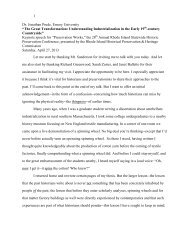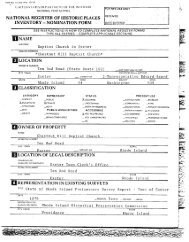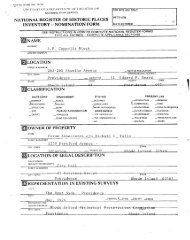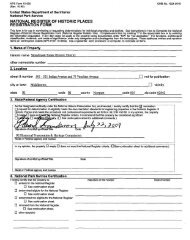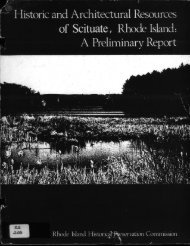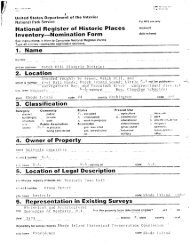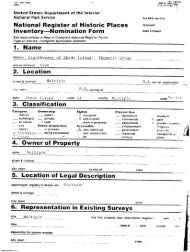National Park Service - Rhode Island Historical Preservation ...
National Park Service - Rhode Island Historical Preservation ...
National Park Service - Rhode Island Historical Preservation ...
Create successful ePaper yourself
Turn your PDF publications into a flip-book with our unique Google optimized e-Paper software.
P8,Form 10-900’.<br />
0MB IC 1024-0018<br />
- Eap- 10-31-84<br />
United States Department of the Interior<br />
<strong>National</strong> <strong>Park</strong> <strong>Service</strong><br />
<strong>National</strong> Register of Historic Places<br />
Inventory-Nomination Form<br />
Continuation sheet 5 Item number 7<br />
Page<br />
street, with many minor variations in design. They date as early<br />
as c.1860 and as late as c.1900. Many were company-built,<br />
providing an alternative to multi-unit housing. Of this last<br />
type of housing some 30 examples carl be found. Unlike the<br />
cottages just described, they follow no one pattern, ranging from<br />
1-1/2-story, flank-gable, 2-unit structures to 8-unit, 2-story,<br />
hip-roofed buildings.. There are even two mansard-roofed former<br />
rooming houses. It appears that the multi-unit buildings were<br />
clustered off the main streets and consciously’ arrayed to avoid<br />
the look of a typical company town.<br />
Authorship plays a distinctive role in Peace Dale’s visual<br />
coherence. As noted, the primary era of development here was<br />
between 1860 and 1895. Throughout that period one man, Rowland<br />
Hazard II who in association with other members of his family<br />
owned and operated the mills, had control over Peace Dale’s<br />
architectural development. He was himself an amateur architect<br />
and designed quite a number of structures, beginning, with the<br />
mill and the office building erected in 1856 #37E and 40, the<br />
1872 worsted mill #37F, the Congregational Church #104, a<br />
whole series of stone-arch bridges erected in the early 1880s<br />
#35, 78, 92, 93, 162, and an addition to the church’ built in<br />
1895. Other buildings are attributed to Hazard, notably the mill<br />
office #37A of 1881. He was’ responsible for building dozens of’<br />
other structures, particularly mill houses. The introduction and<br />
prevalence of the L-plan cottage in Peace Dale is credited to.<br />
Rowland Hazard II. He may have designed many of these cottages,<br />
but only four are presently attributed to him: two early,<br />
nominally "Gothic" cottages #88 and 114, and a pair of Queen<br />
Anne L-plan cottages on Kingstown Road #45 and 46. Moreover,<br />
Rowland Hazard called upon a professional architect with whom he<br />
particularly liked to work, Frank Angell, to design at least two<br />
major Peace Dale buildings: the railroad station #82 and the<br />
Hazard Memorial #38. Angell probably also designed The Acorns<br />
for Hazard and certainly planned alterations to the building<br />
#71. Frank Angell’s hand is. likely also found in severallater -<br />
buildings, among them a multi-unit mill house on Kersey Road #9<br />
and a group of company-owned houses on Brown Street, Church<br />
Street, and Indian Run Road dated to the late 1890s #149-151,<br />
154, 164-167. -<br />
Finally, the ambience of Peace Dale augments its unity.<br />
Peace Dale is a very picturesque, quiet, attractive village,<br />
casual in layout yet with a certain quality of kemptness and<br />
amenity which sets it apart. Though the mills are the focus,<br />
they do not-dominate the scene. This is not,the sort of factory







